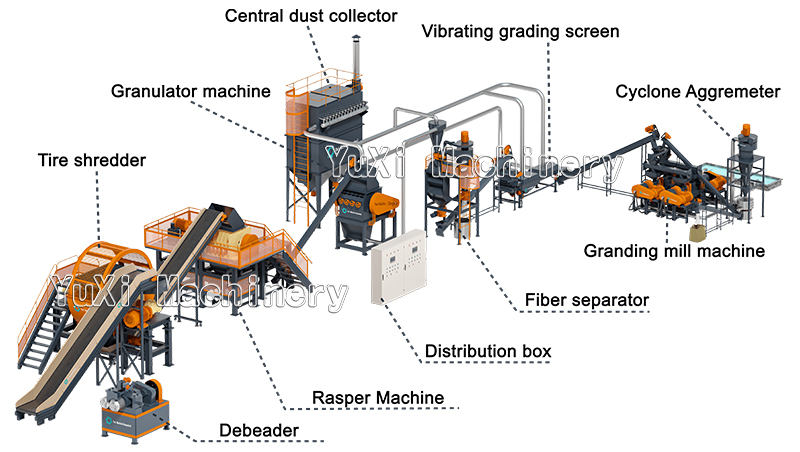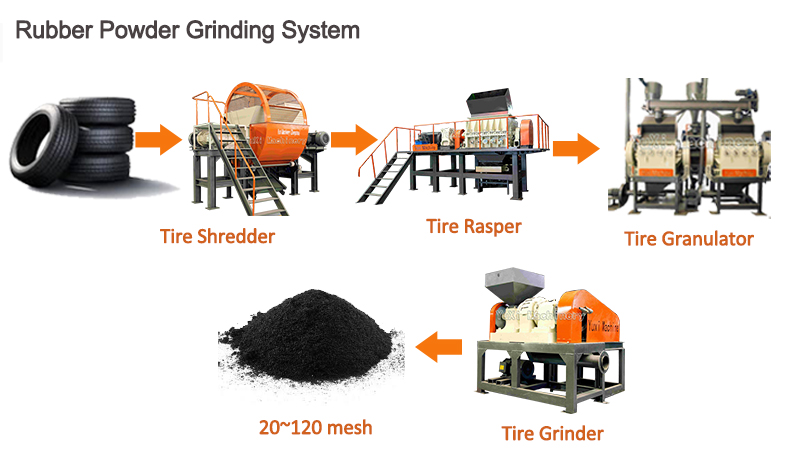In the global wave of the circular economy, waste tires are undergoing a remarkable transformation from “black pollution” to “black gold.” The rubber powder grinding system, a core technology in this transformation, converts tires into high-value rubber powder and pure steel wire. This article will comprehensively unveil this technology, covering its principles, equipment composition, process flow, and application prospects.

The rubber powder grinding system is an integrated tire recycling equipment that converts entire waste tires into fine rubber powder of 20–120 mesh (125–75 microns) through a complete process of shredding—separation—grinding, while simultaneously achieving efficient separation and recovery of steel wire.
Core Values:
1.Tire Shredder
2.Tire Rasper (Steel Wire Separator)
3.Tire Granulator
4.Tire Grinder (Rubber Mill)
5.Central Dust Collector
6.Vibrating Grading Screen
7.Cyclone Aggremeter

1.Coarse Shredding Stage
Waste tires (passenger car, truck, etc.) first enter the tire shredder, where they are shredded into uniform rubber blocks under strong shear force, preparing them for subsequent fine separation.
2.Steel Wire Separation Stage
Rubber blocks enter the tire rasper, where rubber and embedded steel wire are completely separated through high-speed rotation and physical friction. Separated steel wire can be directly sold as high-quality scrap steel.
3.Fine Granulation Stage
Purified rubber blocks are fed into the granulator, where they are extruded and die-cut into uniform rubber granules. This stage is critical for ensuring subsequent grinding results.
4.Fine Grinding Stage
Uniform rubber granules enter the tire grinder, where they are processed into 20–120 mesh fine rubber powder through precision grinding. The water-cooled temperature control system ensures normal-temperature operation, extending equipment life.
5.Classification and Collection Stage
Fine rubber powder is precisely classified through a vibrating grading screen to ensure particle size distribution meets requirements. The cyclone aggremeter efficiently collects fine rubber powder, reducing loss.
6.Dust Collection and Packaging Stage
The central dust collector controls dust throughout the process to ensure a clean workshop environment. Finished rubber powder is screened and packaged according to customer requirements.
1.High Efficiency and Yield
Automated production line design provides strong processing capacity and continuous stable operation, significantly improving recovery efficiency.
2.Pure Products
Multi-stage separation process (steel wire separation + fine grinding) ensures the production of high-purity, low-impurity, and high-market-value rubber powder.
3.Controllable Particle Size
Finished product fineness can be flexibly adjusted between 20–120 mesh to meet different downstream application needs.
4.Fast Return on Investment
Converts waste tires into directly marketable rubber powder and steel wire, creating sustainable economic benefits.
5.Durability
Core components of the equipment are made of high-strength, wear-resistant materials, capable of withstanding the harsh conditions of tire shredding, ensuring a long service life.
6.Environmental Compliance
Fully enclosed dust collection throughout the process; emission indicators exceed national standards, meeting the strictest environmental requirements.
7.Modular Design
Modular design allows flexible configuration based on customer production needs, facilitating installation, replacement, inspection, and maintenance.
Processable Raw Materials:
Final Products:
Application Areas:
With the growing global emphasis on environmental protection and resource recycling, the waste tire recycling industry is entering a period of rapid development. The rubber powder grinding system, as a key technology for high-value utilization of tires, continues to see increasing market demand.
Economic Benefit Analysis (based on annual processing of 10,000 tons of waste tires):

1.Technological Innovation Directions
2.Industrial Chain Extension
3.Global Layout
With the increase in vehicle ownership in developing countries, demand for waste tire disposal will grow rapidly, shifting market focus to emerging markets.
The rubber powder grinding system is not only a technological innovation but also key to the resource utilization of waste tires. It transforms “black pollution” into “black gold,” making significant contributions to the circular economy and sustainable development. With continuous technological progress and market maturation, this system will undoubtedly play an increasingly important role in future waste tire recycling.